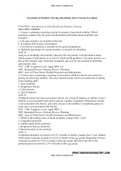Summary
Summary advanced management accounting
- Course
- Institution
- Book
I offer my summary of the advanced management accounting course for sale. This summary contains all the mandatory reading materials of this course (the book chapters of Groot & Selto as well as the scientific articles). But it excludes notes of the lectures and tutorials. The summary is 95 pages lo...
[Show more]







